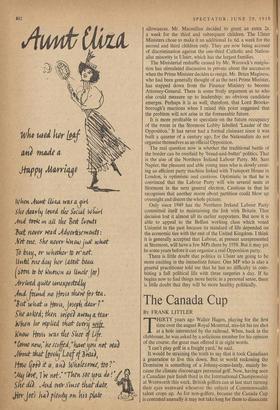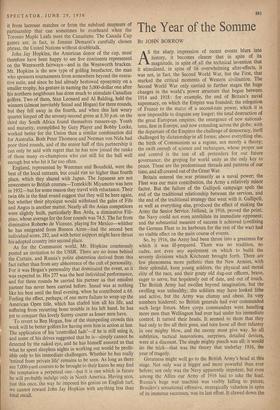The Canada Cup
BY FRANK LITTLER THIRTY years ago Walter Hagen, playing for the first time over the august Royal Montreal, mis-hit his tee shot at a hole intersected by the railroad. When, back in the clubhouse, he was asked by a solicitous member for his opinion of the course, the great man offered it in eight words.
`I can't play golf in a freight yard,' he said.
It would be straining the truth to say that it took Canadians a generation to live this down. But in world reckoning the Dominion is something of a Johnny-come-lately, mainly be- cause the climate discourages perennial golf. Now, having seen a Canadian pair finish third in the International Championship at Wentworth this week, British Offers can at last start turning their eyes westward whenever the subject of Commonwealth talent crops up. As for non-golfers, because the Canada Cup is contested annually it may not take long for them to dissociate it from lacrosse matches or from the subdued murmurs of partisanship that can sometimes be overheard when the Toronto Maple Leafs meet the Canadiens. The Canada Cup games are, in fact, in Jimmie Demaret's carefully chosen phrase, the United Nations without doubletalk.
John . Jay Hopkins, the American donor of the cup, must therefore have been happy to see five continents represented on the Wentworth fairways—and in the Wentworth bracken. Mr. Hopkins is the new type of golfing benefactor, the man who sponsors tournaments from somewhere beyond the execu- tive suite, and since he had already bestowed eponymity on a smaller trophy, his gesture in naming the 5,000-dollar one after bis northern neighbours has done much to stimulate Canadian golfers. Two of them, Stan Leonard and Al Balding, held the winners (almost inevitably Snead and Hogan) for three rounds, but they fell away in the fourth, and when this last weary quartet limped off the seventy-second green at 8.30 p.m. on the third day South Africa found themselves runners-up. Youth and maturity, exemplified by Gary Player and Bobby Locke, worked better for the Union than a similar combination did for Australia. Both Peter Thomson and Norman von Nida had poor third rounds, and of the senior half of this partnership it can only be said with regret that he has now joined the ranks of those many ex-champions who can still hit the ball well enough but who hit it far too often.
England, represented by Weetman and Bousfield, were the best of the local entrants, but could rise no higher than fourth place, which they shared with Japan. The Japanese are not newcomers to British courses—Tomekichi Miyamoto was here in 1932—but for some reason they travel with reluctance.-Their twin 68s in the final round.suggest that they will be here again, but whether their physique would withstand the gales of Fife and Angus is another matter. Nearly all the Asian competitors were slightly built, particularly Ben Arda, a diminutive Fili- pino, whose average for the four rounds was 74.5. The far from diminutive Roberto de Vicenzo, playing for Mexico—whither he has emigrated from Buenos Aires-Thad the second best individual score, 282, and with better support might have thrust his adopted country into second place.
As for the Communist world, Mr. Hopkins courteously posted an invitation to the USSR. There are no irons behind the Curtain, and Russia's polite abstention derived from this fact rather than from any abhorrence of the cult of personality. For it was Hogan's personality that dominated the event, as it was expected to. His 277 was the best individual performance, and for three rounds he carried his partner as that eminent partner has never been carried before. Snead was at nothing like his best until the final evening, when he contributed a 68. Feeling the effect, perhaps, of one more failure to wrap.up the American Open title, which has eluded him all his life, and suffering from recurring bone trouble in his left hand, he has yet to conquer this lovely Surrey course as lesser men have.
To revert to Ben Hogan, few of the stampeding crowds this week will be better golfers for having seen him in action at last. The application of his 'controlled fade'—if he is still using it; and some of his drives suggested that he is—simply cannot be detected by the naked eye, and he has himself assured us that what he spent sleepless nights in working out would be profit- able only to his immediate challengers. Whether he has really `retired from private life' remains to be seen. As long as there are 7,000-yard courses to be brought to their knees he may find the temptation a perpetual one—but it is one which in future he will probably indulge only in North America. Having seen, just this once, the way he imposed his genius on English turf, we cannot reward John Jay Hopkins with anything less than total recall.



































 Previous page
Previous page